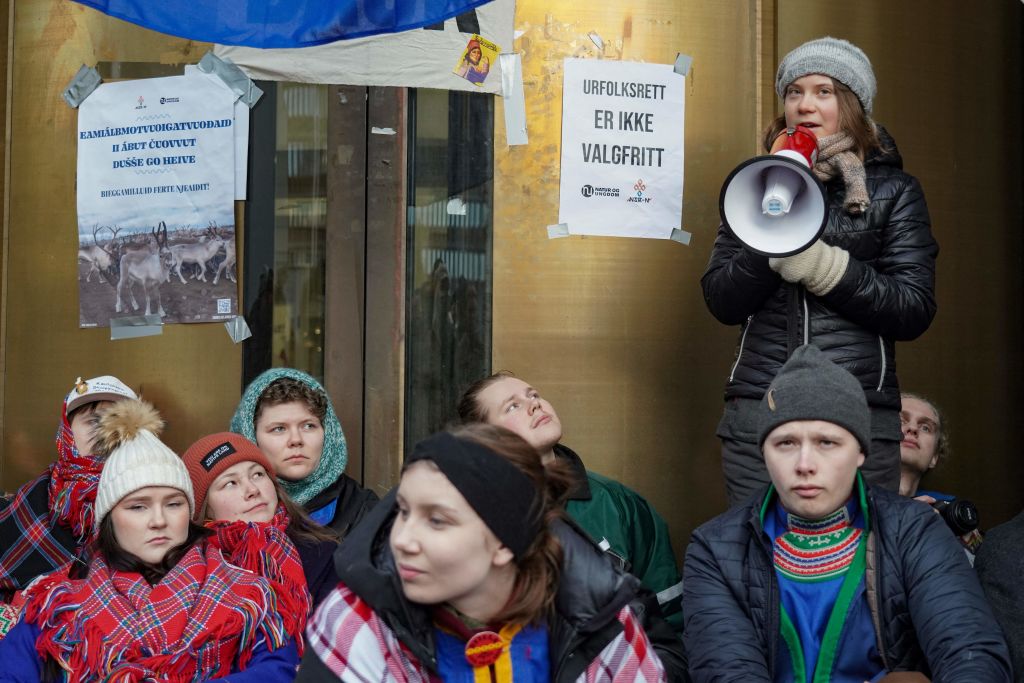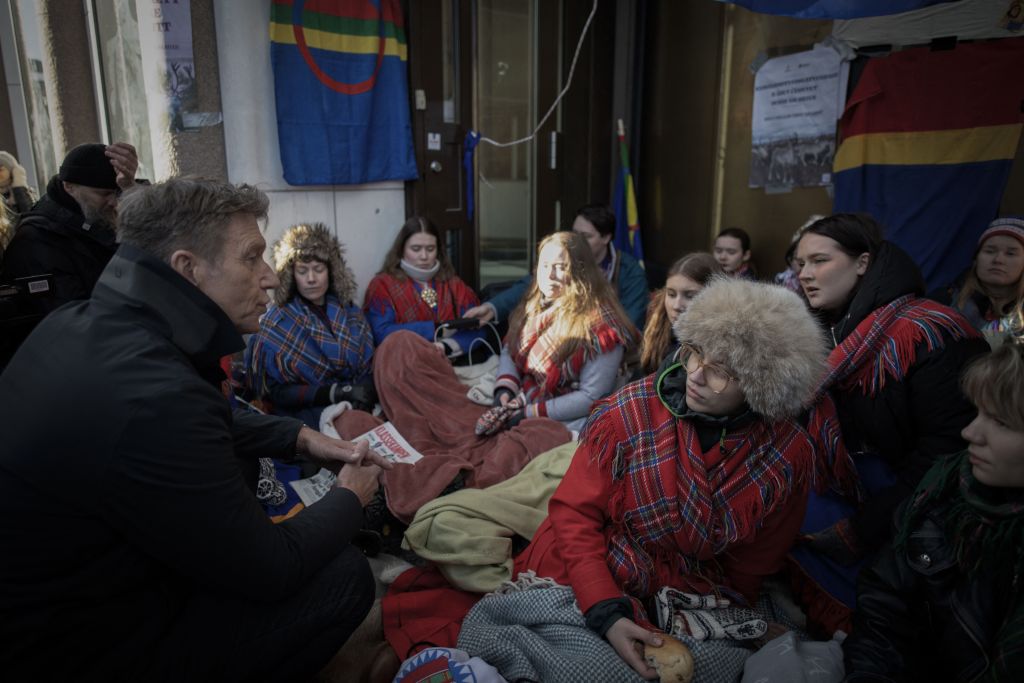
The scene in downtown Oslo this week is hardly unusual in the era of climate protest: chained to doorways and bundled up in thick blankets, Greta Thunberg and dozens of other young activists are blocking the entrance to Norway’s energy and finance ministries to challenge government climate policy. But this time, their target may surprise you: wind farms.
Thunberg and other climate campaigners are joining a demonstration led by the Saami community, an Indigenous group whose traditional lands stretch across Norway, Sweden, Finland, and western Russia. The protest, which kicked off Monday, aims to pressure the Norwegian government to take down 151 turbines that make up two wind farms in the Fosen region of central Norway. Completed in 2020, the wind farms sit on lands that the Saami use for reindeer herding—a central part of their lifestyle. Herders say their animals are terrified by the noise and sight of the turbines, which are 285 ft. tall, leaving the lands unsuitable for grazing and the fate of the area’s Saami in jeopardy.
Protesters claim Norway is breaking the law by keeping the turbines running. In October 2021, Norway’s Supreme Court ruled that their construction violated the Saami’s protected cultural rights under a U.N. treaty and that the energy ministry’s decision to license them was “invalid.” But it stopped short of ordering the removal of the turbines—which are owned by Norwegian energy companies Statkraft and TrønderEnergi, German utility Stadtwerke Muenchen, and Denmark’s Nordic Wind Power DA. More than 500 days later, the turbines are still running, as the energy ministry continues to investigate whether it can modify them in some way to allow them to operate while also satisfying the Saami’s rights.

The comes amid a global land crunch triggered by the fight against climate change. Norway, the world’s 11th largest oil producer, has launched full-tilt into a green transition, expanding clean energy sources that require a lot more land than fossil fuels. The country has tripled its onshore wind capacity since 2018, to 4.8 GW. The two Fosen wind farms are part of Europe’s largest onshore wind development. Adding to land demand, Norway is also planning major electric grid expansions, new mines to provide minerals needed for batteries and electric vehicles, and forestry projects to absorb carbon dioxide from the air.
The resulting pressure is worsening an already fraught relationship between the state and Saami groups. “We need to be better at having a dialogue with Saami interests,” says Amund Vik, state secretary for the energy and petroleum ministry. “But there’s also no doubt that we need to produce more energy and build more grids, to allow for industrial activity, employment opportunities, reasonable electricity prices all over the country, and to meet our climate targets.”
More from TIME
Indigenous leaders say governments around the world are failing to strike a balance between those interests and their own. It’s fueling increasing pushback to the projects officials are necessary to decarbonization. Just last week in the U.S., the National Congress of American Indians called for an immediate halt to the development of the U.S.’ burgeoning offshore wind industry, arguing that its members are not being adequately consulted. Indigenous and climate activists from Latin America to Africa have also staged protests challenging a U.N. backed goal to conserve 30% of the world’s lands by 2030, which many fear will lead to the co-opting of Indigenous territories.

Norway and other countries are repeating the exploitative dynamics of previous, fossil-fueled eras of industrial development, says Åsa Larsson Blind, vice president of the Saami Council, who grew up in a reindeer-herding community in Sweden. “We call it green colonialism, because it’s in the name of combating climate change, but on the ground, for affected communities, the consequences are the same.”
Saami and other communities, she says, are being asked “to give up their culture and their children’s possibilities to continue their way of life,” so that “other societies” can decarbonize their own high-consumption lifestyles. “Is that fair?”
A Stalled Way Forward
Vik, the energy ministry official, says there are many options on the table to bring the wind farms in line with the government’s obligations to the Saami. That includes full decommissioning, removing a few turbines, or removing some roads. There may also be a way to address the reindeer herders’ needs by creating new grazing areas, or offering more monetary compensation than they were initially given.
But Knut Helge Hurum, a lawyer who represents one group of herders, says the only solution is for the turbines to be torn down. He claims the consultation process between the government and herders since the 2021 verdict has been “like talking to a wall. … They have had 500 days and very little has been produced from their side.”
The reindeer herders first began mounting their legal challenges in 2014, before construction began. Some Saami activists argue that the government should adopt a policy halting construction of wind turbines to allow legal challenges like theirs run their course.
Vik, however, says that would be impractical—in part because many other groups, such as landowners, file similar lawsuits over the expropriation of land and compensation for green energy projects. “If you’re going to wait for all those legal battles, nothing will be built, or everything will take a very long time.”
Indigenous Tokenization
Time is certainly a factor when it comes to clean energy. By 2030, the Paris-based International Energy Agency says the world needs to have installed 1,200 GW of solar, wind, and other clean energy sources—four times the amount that existed in 2022. If we don’t, global warming will intensify to catastrophic levels, which would also be disastrous for many Indigenous communities’ ways of life.
While Indigenous communities have made inroads in the global climate conversation in recent years, winning recognition in the media and at U.N. climate summits for the outsize contribution that they have made to protecting nature, activists say they are still being ignored when it comes to actual decision making about energy and biodiversity. In Tanzania, for example, authorities drove Masaai people out of their lands last year to make way for a nature reserve. On Friday, legislators in Finland blocked a vote on legislation that would have granted its Saami representatives a say over clean energy and mining projects in their territories.
Protests like the ones in Oslo this week are disrupting that kind of tokenization, says Larsson Blind, the Saami council member. “People will see that it’s no longer possible to only include Indigenous peoples when it comes to showing [off] their cultures at [summits],” she says.
The hope, she adds, is to set a precedent ahead of future decisions on mining and grid expansion projects coming down the pipeline in Norway. “We will assert our human rights. And we are getting stronger and stronger.”
More Must-Reads from TIME
- How Donald Trump Won
- The Best Inventions of 2024
- Why Sleep Is the Key to Living Longer
- How to Break 8 Toxic Communication Habits
- Nicola Coughlan Bet on Herself—And Won
- What It’s Like to Have Long COVID As a Kid
- 22 Essential Works of Indigenous Cinema
- Meet TIME's Newest Class of Next Generation Leaders
Write to Ciara Nugent at ciara.nugent@time.com